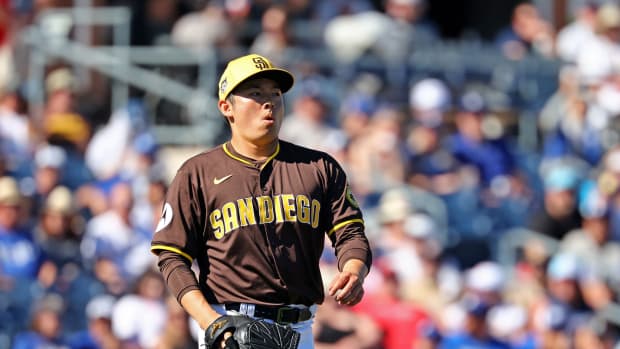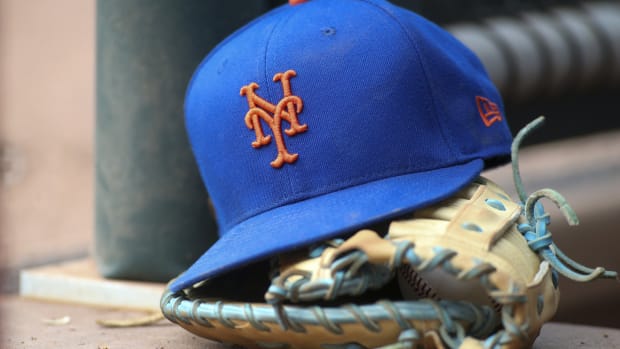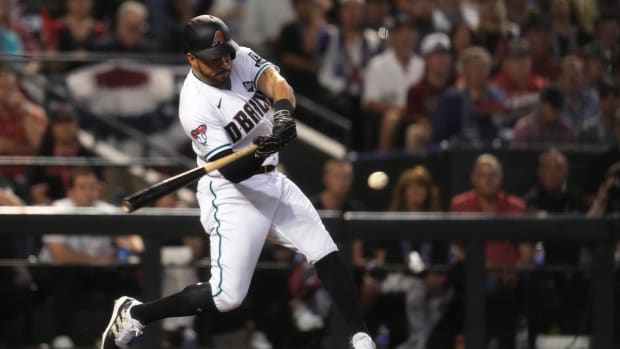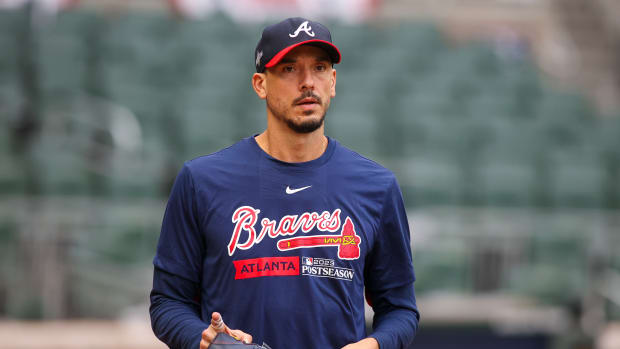Albert Pujols's 3000th Hit Reminds Us Just How Brilliant He Was in His Prime
When the end comes for Albert Pujols, what will we say? He’s a no-brainer Hall of Famer, one of the greatest righthanded hitters in history and a Cardinals franchise icon despite having taken his last at-bat for St. Louis toward the tail end of Barack Obama’s first presidential term. He has also, over the last seven years and particularly the last two, been one of the game’s worst players—a shell of the shell of himself thanks to a decline that’s been as precipitous as it has baffling.
How you feel about Pujols depends on a number of factors, but we’re revisiting it now that he’s added yet another round number to a career stacked full of them. On Friday, the Angels’ longtime designated hittersingled to right off Mariners starter Mike Leake in the fifth to reach 3,000 hits for his career. Pujols becomes the 32nd man all-time to join the 3,000 Hit Club and the third active player, alongside Ichiro Suzuki (3,089, although he's no longer technically active), who did it in 2016, and fellow Dominican star Adrian Beltre (3,075), who reached that hallowed ground last season.
That Pujols got here isn’t necessarily a surprise, given how good he was for the first decade of his career, but it has been a grind. So far this season, the aging slugger has looked every bit the part, hitting just .256/.284/.450 for an OPS+ of 99. That’s of a piece with Pujols’s appalling campaign last year, when he posted a .241/.286/.386 line and an 80 OPS+ that made you wonder if he had anything at all left to give.
The Best Moments of Ichiro Suzuki's MLB Career Now That His Retirement Is Official
Amid the wreckage of that 2017 season, though, Pujols did manage to collect his 600th career home run, which he hit on June 4 against Minnesota’s Ervin Santana (and it was a grand slam, no less). Now, as he tries to bounce back in his 18th major league season, he’s added a 3,000th hit to that tally, putting him in one of the most exclusive clubs in the game’s history. Only three other hitters have reached both of those milestones: Alex Rodriguez, Willie Mays and Hank Aaron. That’s two inner-circle Hall of Famers and a man in A-Rod who would be one had it not been for all his steroid-fueled drama. Considering the breadth of Pujols’s career, it’s an appropriate landing spot for him as well.
There is no debate—none at all—as to whether Albert Pujols is a Hall of Famer. He could have retired or had his career cut short after leaving the Cardinals following the 2011 season, and his output solely from the first 11 years of his career—2,073 hits, 445 homers, a .328/.420/.617 line, a 170 OPS+ and 86.6 Wins Above Replacement—would have made him worthy of a bronze plaque in Cooperstown, to say nothing of the three NL MVP awards, the Rookie of the Year in 2001, nine All-Star nods and two World Series rings. The question is whether Pujols qualifies as one of the game’s true elites—and there’s not much to be argued over there either.
Start with WAR. Pujols has racked up 99.6 Wins Above Replacement in his career, good for 32nd all time among major leaguers and 21st among position players. He’s been more valuable over the course of his career than Hall of Famers Eddie Mathews, Carl Yastrzemski, Jimmie Foxx, Cal Ripken Jr., Roberto Clemente, Cap Anson and dozens more. Among first basemen, meanwhile, Pujols trails only one man in WAR: Lou Gehrig, the greatest of all time at that position. By Jay Jaffe’s handy JAWS tool—which uses WAR to measure a player against his contemporaries in the Hall of Fame—Pujols long ago destroyed the standards for first base. And even if you’re not a fan of the advanced metrics, the simple counting stats are equally on his side.
Pujols’s path to Cooperstown was laid out long ago. When he put pen to ink on his new 10-year, $240 million contract with the Angels in December 2011, he did so just a month away from his 32nd birthday. To that point, he had put up more WAR through his age-31 season than just seven other players in major league history—again, all of them the elite of the elite.
player | years | war |
Ty Cobb | 1905–18 | 104.3 |
Rogers Hornsby | 1915–27 | 100.5 |
Alex Rodriguez | 1994–2007 | 94.4 |
Mickey Mantle | 1951–63 | 93.7 |
Babe Ruth | 1914–26 | 91.0 |
Hank Aaron | 1954–65 | 88.4 |
Willie Mays | 1951–62 | 87.5 |
Albert Pujols | 2001–11 | 86.6 |
As Pujols exchanged his Cardinals red and white for Angels … uh, red and white, the speculation turned to what exactly his ceiling could be, and how much higher he could go. Even with his mid- and late-30s facing him, why couldn’t Pujols keep raking his way past 100 WAR and challenging the likes of Mantle, Gehrig or Ted Williams—or even take aim at Barry Bonds, the final boss of all MLB hitters?
Instead, the second half of Pujols’s career has been a rollercoaster drop without end. Since joining Los Angeles, he's fallen apart, producing a mere 13.0 WAR over the last seven-plus seasons, or just 2.5 WAR more than teammate Mike Trout did in 2016 alone. Blame his fall on whatever factors you’d prefer: declining bat speed; persistent injury problems with his right foot that crippled him defensively and destroyed his already bad base-running abilities; or the inevitability of aging. The result is a player who went from historic levels of production to turning into a ghost after his 32nd birthday.
(It’s worth noting that Pujols’s collapse would make more sense, both logically and narratively, if, as it turns out, he were older than his listed age of 38. That’s a subject that Baseball Prospectus’ Matt Trueblood dove into last week based on some comments Pujols made in an interview earlier this season, and it’s a piece that’s well worth your time.)
The divide between young Pujols and what he is today is stark and unprecedented. To illustrate it, I looked for Hall of Famers who played 850 or more games from age 32 onward (Pujols has played in 901 since joining the Angels) and were worth less than 20 total WAR over those years. Among that group, Pujols’s 13.0 WAR would be sixth worst. That number could keep dipping, too: He was worth -1.8 WAR last season, making him the worst regular player in the game, and he checks in at just 0.2 WAR so far this year.
player | WAR | AGE | games |
Ken Griffey Jr. | 5.7 | 32–40 | 880 |
George Sisler | 6.2 | 32–37 | 857 |
Rabbit Maranville | 7.5 | 32–43 | 1,174 |
Ernie Banks | 10.0 | 32–40 | 1,158 |
Lou Brock | 12.2 | 32–40 | 1,245 |
Albert Pujols | 13.0 | 32–38 | 901 |
Ivan Rodriguez | 13.8 | 32–39 | 920 |
Kiki Cuyler | 15.3 | 32–39 | 926 |
Eddie Murray | 15.5 | 32–41 | 1,367 |
Reggie Jackson | 15.8 | 32–41 | 1,309 |
Unsurprisingly and perhaps fittingly for Pujols, the name atop this list is Ken Griffey Jr., another player who went from awe-inspiring start to the bottom of the barrel after changing teams and passing 30 years of age. That two of the game’s all-time greats both saw their careers come to such ignominious ends—in which they gradually and irreversibly decayed—is a saddening reminder that time always wins.
But it’s also a sign of how much more the good endures beyond the bad. When Griffey’s time came on the Hall of Fame ballot, no one held the putrid second half of his career against him, when his broken body betrayed him over and over again while with the Reds. They all remembered and celebrated Junior, the kid who wore his hat backwards and robbed home runs when he wasn’t crushing them. Like Pujols, the titanic numbers that Griffey put up at the beginning more than made up for the way he limped across his career’s finish line. He set the all-time record for highest percentage of the vote in Hall of Fame history, and while Pujols is unlikely to challenge such a transcendently popular player in that category, he will almost certainly finish with 95% or more of the electorate’s support.
The story of Albert Pujols won’t be that miserable decade in Orange County or the hundreds of empty at-bats as a struggling DH. It’ll be the three home runs in the World Series, or the mechanical way in which he raked, or the time he briefly banished Brad Lidge to the Phantom Zone. For 11 years, Albert Pujols was one of the most frightening hitters the game has ever produced, and he did it as a completely unheralded nobody who was drafted in the 13th round out of a Missouri community college. That kind of career is a marvel.
Barring him winning another World Series ring, Pujols’s 3,000th hit will be one of the last chances to appreciate everything he’s accomplished until he retires. (That’s particularly the case given that Pujols will be the last man to 3,000 hits for at least a few years; the next highest total among active players is Miguel Cabrera’s 2,666.) The last days of Albert Pujols have been a struggle, but that doesn’t mean we can’t or shouldn't remember the better times.




































